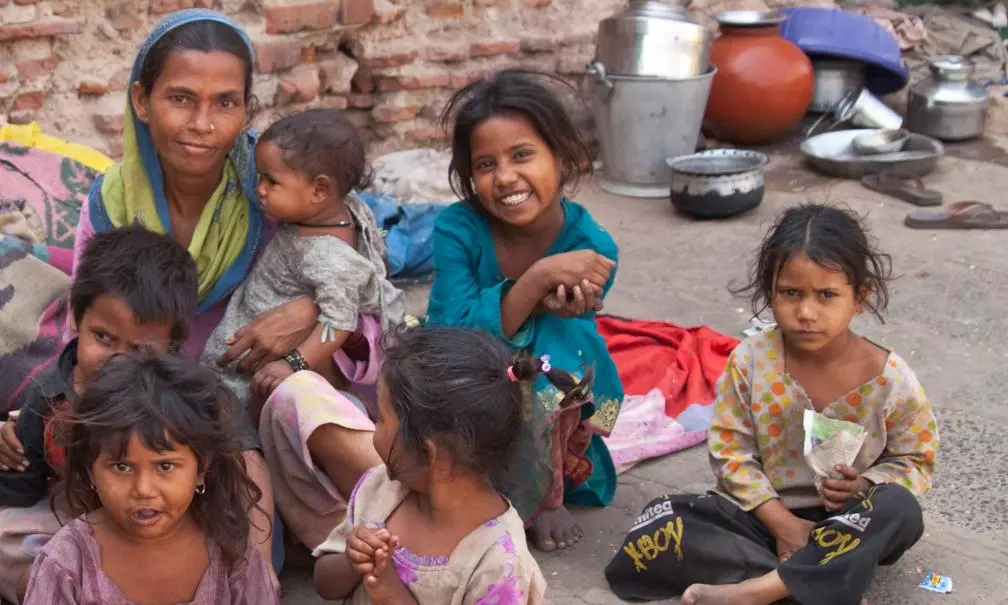
Gujarat's paradox: High per capita income, but poor health, nutrition levels
While lower-income states like Bihar, MP and UP have improved their health parameters, Gujarat, despite being wealthier, has seen women and children's health worsening

The Gujarat government is patting itself on the back for stated improvements in the healthcare sector but a recently released NITI Aayog report has a different story to say.
According to the BJP government in Gujarat, the state has achieved the first rank in the country for the second consecutive time in the ‘Good Health and Well Being’ category of the SDG India Index 2023-24.
Elated Chief Minister
“It is a matter of great joy and pride that in the SDG Index announced by NITI Aayog, Gujarat has ranked first in the country for the second time in a row in the category of Good Health and Well Being,” Chief Minister Bhupendra Patel said.
“We could achieve this due to a major reduction in maternal and child mortality, institutional delivery and increase in complete immunisation of children,” he told an event called to congratulate healthcare workers.
However, a glance at the Sustainable Development Goal (SDG) Index for 2023-24 published by NITI Aayog reveals that Gujarat still has a long way to go on almost all the healthcare parameters.
Low ranks and numbers
According to NITI Aayog's Multidimensional Poverty Index (MPI), 38.09 per cent of the population in Gujarat is still undernourished. Nearly half of the rural Gujarat population is deprived of nutrition, with 44.45 per cent undernourished while 28.97 per cent of the people are undernourished in the urban areas.
Gujarat ranked fourth in terms of stunted children, with 39 per cent of children underweight for their age. This number has been constant at 39 per cent for the past four years.
State of children
Despite faring well on economic parameters for years, Gujarat has consistently ranked second for two years in terms of wasted and underweight children.
With 25.1 per cent children wasted and 39.7 per cent underweight in both urban and rural areas since 2022, there has been no improvement in health parameters amongst children.
In the last week of July, six children died in two villages of Kutch whose deaths were later attributed to malnutrition by the district health authorities.
Economist moans failures
A staggering 38 per cent of children in Gujarat suffer from malnutrition, Prof Hemant Shah, an economist, told The Federal. “NITI Aayog’s MPI report was released just two weeks after the incidents revealing disturbing facts about the healthcare system in the state," he added.
“Gujarat had managed to reduce its malnutrition rates from 41.37 per cent to 38.09 per cent between 2019 and 2021 but the figure has been stagnant since then. Nothing can be more unfortunate than children dying of malnutrition in a state that boasts of being a model state with a high GDP,” he said.
“Compared to other states with similar GDP, the plight of Gujarat is very grim and efforts are needed to address the basic issues,” he added.
Poor nutrition levels
Gujarat has long been hailed for its per capita income, which consistently exceeds the national average.
According to 2021-22 estimates, the state’s per capita income is Rs 2.5 lakh per annum as against the national average of Rs 1.72 lakh. Indeed, the Gujarat government began touting the state as a model of development way back in 2012.
But according to Shah, underneath the claims of a developed state are the subpar nutrition levels among children and distressing infant and maternal mortality rates.
Anaemia concerns
National Family Health Survey (NFHS) data reveal that the percentage of children aged six to nine in Gujarat suffering from anaemia increased from 62.6 per cent in 2015-16 to 79.7 per cent in 2019-21.
Gujarat, despite its relatively advanced economic status, has shown a deterioration in key nutritional indicators compared to lesser developed states.
In 2018, 38.5 percent of children under five in Gujarat were stunted. By 2023-24, the figure rose to 39 per cent.
Better performing states
In comparison, during the same period, Bihar's stunting rate decreased from 48.3 per cent to 42.9 per cent, of Madhya Pradesh from 42 per cent to 35.7 per cent and of Uttar Pradesh from 46.3 per cent to 39.7 per cent.
Similarly, anaemia among pregnant women in Gujarat has worsened over the years. In 2018, 51.3 per cent of women in both urban and rural areas were anaemic. This went up to 62.5 per cent in 2023-24.
Gujarat in aspirant category
From 2018 to 2023-24, Gujarat remained in the aspirant category of the NITI Aayog report with no significant progress in healthcare parameters.
The state's score declined from 46 in 2018 to 41 in 2023-24 with no improvement between 2019-20 and 2023-24.
